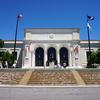More about Cotopaxi
- All
- Info
- Shop

Sr. Contributor
Frederic Edwin Church proves that Cotopaxi isn’t the brand name of ridiculously overpriced activewear for no reason.
Cotopaxi is an Ecuadorian volcano in the Andes mountains and is located a nerve-wracking thirty-seven miles away from the country’s capital, Quito. Now, it’s no surprise that volcanoes erupt; it’s what they do. But Cotopaxi is a stratovolcano, a type of volcano that can erupt thousands of times over its millions of years in existence. It’s also part of the “Ring of Fire.” No, not that song by Johnny Cash. It's the hundreds of active volcanoes that surround the Pacific Ocean. But this is just the sort of danger and majesty that drew the Romantics to dramatic scenes of natural wonder.
As a member of the second generation of Hudson River School painters, Church wasn’t afraid to stray from the scenic Hudson Valley in search of a nice vista. Influenced by the German explorer and writer Alexander von Humboldt’s hippie-dippy philosophy about the interconnectedness of nature, he went to Ecuador in search of landscapes that demonstrated the divine power of nature. He traveled to this region of South America multiple times, making his first trip in 1853. During these trips, Church made sketches to prepare for as many as ten later paintings of the mighty volcano. He painted this view in 1857, just before his second trip south.
Like many other Romantic artists, Church contemplated the idea of the sublime in nature. It’s easy to imagine yourself as the small figure in the lower right corner, marveling at the view. Although smaller, this figure recalls the Rückenfigur of the Caspar David Friedrich’s work work of the same name, later interpreted in 2009 by Glenn Ligon.
Much like Emanuel Leutze’s work Washington Crossing the Delaware, Cotopaxi is full of lies. Church exaggerated the volcano’s shape, creating a perfect cone. More importantly, the real Cotopaxi is in a barren landscape, not surrounded by the beautiful vegetation that he painted. In a classic Church move, he invented the landscape around the volcano to create what he thought would be an ideal image. Unfortunately, this cognitive dissonance was of the same kind that fueled the imperialist point of view that this land was ripe for the taking.
Sources
- Encyclopedia Britannica. “Cotopaxi.” Mountains & Volcanoes. https://www.britannica.com/place/Cotopaxi. Accessed 24 September 2020.
- Encyclopedia Britannica. “Edward Whymper.” Nonfiction Authors L-Z. https://www.britannica.com/biography/Edward-Whymper#ref57942. Accessed 24 September 2020.
- Klemetti, Erik. “A Restless Volcano Puts Ecuador on Edge Once More.” Wired. 17 June 2015. https://www.wired.com/2015/06/restless-volcano-puts-ecuador-edge/. Accessed 24 September 2020.
- Smithsonian Institution. “Cotopaxi.” National Museum of Natural History. Global Volcanism Program. 2013. https://volcano.si.edu/volcano.cfm?vn=352050. Accessed 24 September 2020.
- Stark, David, and Lara Taylor. American Art. Chicago: The Art Institute of Chicago, 2008. https://www.artic.edu/assets/fbe5ae4e-e5ce-2220-2494-5751032e037b. Accessed 24 September 2020.
- The Art Institute of Chicago. “View of Cotopaxi.” Collection. https://www.artic.edu/artworks/76571/view-of-cotopaxi. Accessed 25 September 2020.
- The Art Story. “Frederic Edwin Church.” Artists. https://www.theartstory.org/artist/church-frederic-edwin/. Accessed 24 September 2020.
Featured Content
Here is what Wikipedia says about Cotopaxi (painting)
Cotopaxi is an 1862 oil painting by American artist Frederic Edwin Church, a member of the Hudson River School. The painting depicts Cotopaxi, an active volcano that is also the second highest peak in modern-day Ecuador, spewing smoke and ash across a colorful sunrise. The work was commissioned by well-known philanthropist and collector James Lenox and was first exhibited in New York City in 1863. Cotopaxi was met with great acclaim, seen by some as a "parable" of the Civil War, then raging in the American South, with its casting of light against darkness in a vast tropical landscape. Church first depicted Cotopaxi beginning in 1853 during his first of several travels to South America, forming a series of at least 10 paintings on the subject during his lifetime. Cotopaxi has been called by some art historians the "apex" of the Cotopaxi series or Church's "ultimate interpretation" of the eponymous volcano.
Cotopaxi is currently exhibited by the Detroit Institute of Arts, while other members of the series are housed in various museums and private collections, including the New Britain Museum of American Art, Smithsonian American Art Museum, Museum of Fine Arts, Houston, Art Institute of Chicago, and Yale University Art Gallery.
Check out the full Wikipedia article about Cotopaxi (painting)













